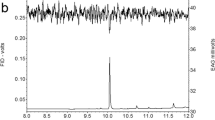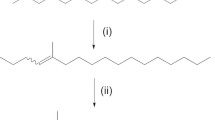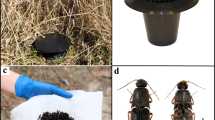Abstract
The elm spanworm, Ennomos subsignaria (Hübner), occurs throughout Canada and the eastern United States and can be a destructive forest pest on a wide range of deciduous trees. Gas chromatography/mass spectrometry (GC/MS) and coupled gas chromatographic–electroantennographic detection (GC/EAD) analysis of pheromone gland extracts, in combination with chemical synthesis and field trapping studies have identified (2S, 3R)-2-((Z)-oct-2′-enyl)-3-nonyl oxirane (hereafter Z6-9S, 10R-epoxy-19:H) as the female-produced sex pheromone. Significantly more male moths were captured between 1–100 μg loadings of this compound on red rubber septa in sticky traps compared to blank (unbaited) traps; catches then declined at higher dosages (500–1000 μg). The other isomeric enantiomer, (2R, 3S)-2-[(Z)-oct-2′-enyl]-3-nonyl oxirane (Z6-9R, 10S-epoxy-19:H), at a 10-μg dosage did not elicit trap capture. The likely precursor to the active epoxide, (Z, Z)-6, 9-nonadecadiene ((Z, Z)-6, 9-19:H), identified in virgin female sex pheromone glands, did not elicit trap capture either, and inhibited trap capture when combined with the active epoxide. Racemic 2-((Z)-oct-2′-enyl)-3-nonyl oxirane showed no significant difference in trap capture compared with Z6-9S, 10R-epoxy-19:H, indicating that the opposite enantiomer was not antagonistic. The addition of the EAD-active diene epoxide enantiomers (2S, 3R)-2-[(Z, Z)-octa-2′, 5′-dienyl]-3-nonyl oxirane or (2R, 3S)-2-[(Z, Z)-octa-2′, 5′-dienyl]-3-nonyl oxirane in admixture with Z6-9S, 10R-epoxy-19:H (at 10% of the latter) did not enhance or decrease trap capture compared to Z6-9S, 10R-epoxy-19:H oxirane alone, so they are not likely pheromone components. This pheromone, impregnated in rubber septa at less than 100-μg dosage, can now be used as a trap bait to develop detection and monitoring strategies for this insect.





Similar content being viewed by others
References
Anderson JF, Kaya HK (1976) Parasitoids and diseases of the elm spanworm. J New York Entomol Soc 84:169–177
Ando T, Inomata S, Yamamoto M (2004) Lepidopteran sex pheromones. Top Curr Chem 239:51–96
Bell TW, Ciaccio JA (1993) Alkylative epoxide rearrangement. A stereospecific approach to chiral epoxide pheromones. J Org Chem 58:5153–5162
Caserio MC, Fisher CL, Kim JK (1985) Boron trifluoride catalysed addition of disulfides to alkenes. J Org Chem 50:4390–4393
Che C, Zhang ZN (2005) Concise total synthesis of (3Z, 6Z, 9S, 10R)-9, 10-epoxy-1, 3, 6-heneicosatriene, sex pheromone component of Hyphantria cunea. Tetrahedron 61:2187–2193
Ciesla WM (1964) Life history of the elm spanworm, Ennomos subsignarius, in the Southern Appalachian Mountains (Lepidoptera: Geometridae). Ann Entomol Soc Am 57:591–596
Dunkelblum E, Tan SH, Silk PJ (1985) Double bond location in mono-unsaturated fatty acids by dimethyldisulfide derivatization and mass spectrometry; application to analysis of fatty acids in pheromone glands of four lepidoptera. J Chem Ecol 11:265–277
El-Sayed AM (2008) The pherobase: database of insect pheromones and semiochemicals. http://www.pherobase.com
Fedde GF (1964) Elm spanworm, a pest of hardwood forests in the Southern Appalachians. J Forest 62:102–104
Fouquet G, Schlosser M (1974) Improved carbon-carbon linking by controlled copper catalysis. Angew Chem Int Ed 13:82–83
Fry HRC, Quiring D, Ryall KL, Dixon PL (2008a) Relationships between elm spanworm, Ennomos subsignaria, juvenile density and defoliation on mature sycamore maple in an urban environment. For Ecol Manage 255:2726–2732
Fry HRC, Quiring DT, Ryall KL, Dixon PL (2008b) Suppression of Ennomos subsignaria (Lepidoptera: Geometridae) on Acer pseudoplatanus (Aceraceae) in an urban forest with bole-implanted acephate. J Econ Entomol 101:822–828
Gibb AR, Comesky D, Berndt L, Brockerhoff EG, El-Sayed AM, Jactel H, Suckling DM (2006) Identification of sex pheromone components of a New Zealand geometrid moth, the common forest looper Pseudocoremia suavis, reveals a possible species complex. J Chem Ecol 32:865–879
Gries R, Gries G, Schaefer PW, Gotoh T, Higashiura Y (1999) Sex pheromone components of pink gypsy moth, Lymantrea mathura. Naturwissenschaften 86:235–238
Johnson WT, Lyon HH (1988) Insects that feed on shrubs, 2nd edn. Cornell University Press, Ithaca, NY
Kaya HK, Anderson JF (1974) Collapse of the elm spanworm outbreak in Connecticut, USA: role of Ooencyrtus sp. Environ Entomol 3:659–663
Millar JG (2000) Polyene hydrocarbons and epoxides: a second major class of lepidopteran sex attractant pheromones. Annu Rev Entomol 45:575–604
Millar JG, Giblin M, Barton D, Underhill EW (1991) Synthesis and field screening of chiral monounsaturated epoxides as lepidopteran sex attractants and sex pheromone components. J Chem Ecol 17:911–929
Morin RS, Liebhold AM, Gottschalk K (2004) Area-wide analysis of hardwood defoliator effects on tree conditions in the Allegheny Plateau. NJ Appl Forest 21:31–39
Schmid CR, Bryant JD (1993) D-(R)-Glyceraldehyde acetonide. Org Synth 72:6–13
Silk PJ, Butterworth EW, Kuenen LPS, Northcott CJ, Kettela EG (1988) Sex pheromone of the purplestriped shootworm, Zeiraphera unfortunana Powell. J Chem Ecol 14:1417–1425
Silk PJ, Kuenen LPS, Alford AR, Lonergan GC, Grant GG (1997) Sex pheromone components of the oak leaf shredder, Croesia semipurpurana. Can Entomol 129:1005–1012
Silk PJ, Sweeney J, Wu J, Price J, Gutowski JM, Kettela EG (2007) Evidence for a male-produced pheromone in Tetropium fuscum (F.) and Tetropium cinnamopterum (Kirby) (Coleoptera: Cerambycidae). Naturwissenschaften 94:697–701
Slessor KN, King GGS, Miller DR, Winston ML, Cutforth TL (1985) Determination of chirality of alcohol or latent alcohol semiochemicals in individual insects. J Chem Ecol 11:371–374
Underhill EW, Palaniswamy P, Abrams SR, Bailey BK, Steck WF, Chisholm MD (1983) Triunsaturated hydrocarbons, sex pheromone components of Caenurgina erechtea. J Chem Ecol 9:1413–1423
Voerman S, Rothschild GHL (1978) Synthesis of the two components of the sex pheromone system of the potato tuberworm moth, Phthorimaea operculella (Zeller) (Lepidoptera: Gelechiidae) and field experience with them. J Chem Ecol 4:531–542
Wong JW, Underhill EW, Mackenzie SL, Chisholm MD (1985) Sex attractants for geometrid and noctuid moths. J Chem Ecol 11:727–756
Yamamoto M, Kiso M, Yamazawa H, Takeuchi J, Ando T (2000) Identification of chiral sex pheromone secreted by giant geometrid moth, Biston robustum Butler. J Chem Ecol 26:2579–2590
Acknowledgements
We thank Gaetan LeClair, Andrea Sharpe, Catherine Desjardins, and Heidi Fry for their technical assistance. We also thank Laura and Julia Coombes for their invaluable help in conducting the field test in Newfoundland in the summer of 2009. A special thanks to Peggy Dixon (Agriculture and Agri-Food Canada, NL) for her coordination efforts in 2009. Funding support was from Natural Resources Canada, Canadian Forest Service, and Ontario Natural Resources through SERG International. J W wishes to thank University of New Brunswick for a scholarship in the Masters program in Chemistry. We thank Jocelyn Millar (University of California Riverside) and Ashot Khrimian (United States Department of Agriculture) for the gift of several epoxide compounds as analytical standards during the exploratory stage of this study. All experiments reported here comply with the laws of Canada.
Author information
Authors and Affiliations
Corresponding author
Rights and permissions
About this article
Cite this article
Ryall, K., Silk, P.J., Wu, J. et al. Sex pheromone chemistry and field trapping studies of the elm spanworm Ennomos subsignaria (Hübner) (Lepidoptera:Geometridae). Naturwissenschaften 97, 717–724 (2010). https://doi.org/10.1007/s00114-010-0687-6
Received:
Revised:
Accepted:
Published:
Issue Date:
DOI: https://doi.org/10.1007/s00114-010-0687-6




